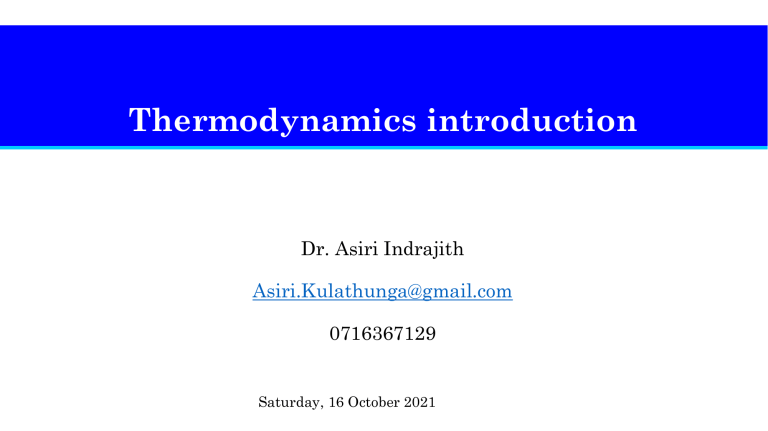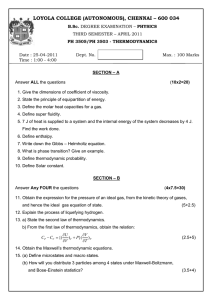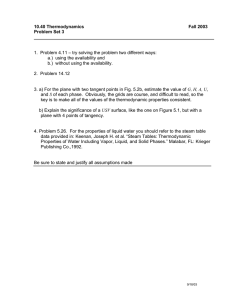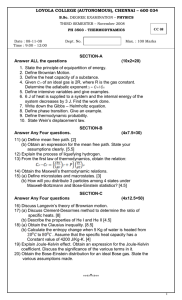
Thermodynamics introduction Dr. Asiri Indrajith Asiri.Kulathunga@gmail.com 0716367129 Saturday, 16 October 2021 Introduction Thermodynamic systems What is thermodynamics • • • The science of energy that concerns with the ways in which the energy is stored within a body. Energy transformation- mostly involve heat and work movement The fundamental law is the conservation of energy principle: energy cannot be created or destroyed, but can only be transformed from one form to another Introduction Thermodynamic systems Heat Is a form or energy which is transferred from one body to another body at a lower temperature. For example, when there is a body with certain temperature around 30 degrees, is brought int contact with the body B at a lower temperature body B. the there will be a heat transfer in-between two bodies until the temperature of A and B are equal. When they come to a same temperature there is no heat transfer between bodies, and they are said to be in thermal equilibrium. Introduction Thermodynamic systems Microscopic and macroscopic thermodynamics • Microscopic thermodynamics: • • All the atoms and molecules of the system are considered and the summation of all the and molecules are used. It is statistical approach of thermodynamics Macroscopic thermodynamics • When matter are considered as continuos function of space variable. It is classical approach of thermodynamics, which requires simple mathematical formula for analyzing the system. Introduction Thermodynamic systems, surrounding and boundary System: Collection of matter within prescribed and identifiable boundaries Open system System in which there is a transfer of mass across the boundaries Introduction Thermodynamic systems, surrounding and boundary Pressure of the system: The pressure of the system is the force exerted by the system on unit area on its boundaries. Here pressure is defined as the absolute pressure. N/m2 or Pa and Bar Absolute, gauge and vacuum pressure: Actual pressure at a given point is called as absolute pressure Most pressure gauge devices care calibrated the value relative to the atmospheric pressure. Therefore, that gives the gauge pressure 𝑷𝒈𝒖𝒂𝒈𝒆 = 𝑷𝒂𝒃𝒔 − 𝑷𝒂𝒕𝒎 Pressure below atmospheric pressure are called vacuum pressure Introduction Thermodynamic systems, surrounding and boundary Introduction Thermodynamic systems, surrounding and boundary A vacuum gauge is connected to a chamber which reads 0.2 Bar at a location where the atmospheric pressure is 1.02 Bar. Determine the absolute pressure in the chamber. Introduction Thermodynamic systems, surrounding and boundary • Variation of pressure with depth. • P= h.z.g • Pressure difference between two points in a constant density fluid is proportional to the vertical distance between the points. Same height points has same pressure. Introduction Systems properties Introduction Systems properties Work: Is defined as the product of a force and the distance moved in the direction of the force. When the boundary of a closed system moves in the direction of the force acting on it, then the surroundings do work on the system. When the boundary is moved outwards the work is done by the system on the surrounding. The unit of the work is Nm. Introduction Systems properties Heat and work are transitory energies and must not confused with intrinsic energy possessed by a system. For example, when a gas contained in a well lagged cylinder is compressed by moving the piston to the left, the pressure and temperature of the gas are observed to increase, and hence the intrinsic energy of the gas increases. The intrinsic energy increase in the gas has been caused by the work done by the piston on the gas. Introduction Systems properties Consider a gas contained in a rigid container and heated, since the boundaries of the system are rigidly fixed then no work is done on or by the system. The pressure and temperature of the gas are observed to increase, and hence the intrinsic energy of the gas will increase. The increase in intrinsic energy has been caused by the heat flow to the system Introduction MCQ 1. Select the correct statement 1. 2. 3. 4. Both molecular weight and total weight of a gas are intensive properties Both molecular weight and total weight of a gas are extensive properties Total weight of a gas is an extensive property molecular weight is an intensive property Total weight of a gas is an intensive property molecular weight is an extensive property 2. The internal energy of a substance 1. 2. 3. 4. decreases with increase in temperature increases with increase in temperature remains unaffected with change in temperature can be calculated by the relation E = mc2 Introduction Thermodynamic systems Thermometer and thermometric property Thermometer and thermometric property Introduction Thank you







